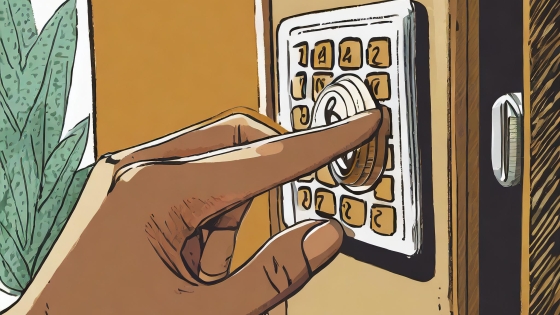
Safe and Secure Gun Storage
When not in use, firearms should be stored locked + unloaded, ammunition should be stored separately (preferably locked up), and key/lock combinations should be inaccessible to children, adolescents, & those at elevated risk of harm to self or others.
The Issue
More than half of all U.S. gun owners store firearms unlocked. Responsible gun ownership is not only about how, where, and when a person uses their firearm; it’s also about how they store it when not in use.
SUICIDE: Far too often someone in crisis gains access to a family member’s firearm that is left unlocked. Suicide is a public health crisis and firearms are the most lethal suicide method. The gun suicide rate has steadily increased, nearly uninterrupted, since 2006. Learn more about firearm suicide.
THEFT: Hundreds of thousands of guns are stolen from homes and cars each year, helping to fuel high rates of gun violence across the country.
UNINTENTIONAL SHOOTINGS: Access to unsecured firearms increases the risk of unintentional injury and death by firearm. Children are often impacted by unintentional firearm injuries by gaining access to an unsecured firearm owned by a parent.
The Solutions
If a person has guns in the home, it is important to always practice safe and secure firearm storage when not in use. Safe and secure are complementary components: safe means unloaded and secure means locked up in a secure place such as a gun safe or lock box. The key or lock combination should only be accessible to authorized users.

Safely storing firearms can reduce gun injuries and deaths, and is supported by researchers, healthcare professionals, and gun owners alike. Research has demonstrated a decreased risk for suicide among adolescents when guns are stored safely. Safe and secure storage practices also help prevent guns from being stolen, diverted into illegal markets and used in gun crime. Gun owners have a responsibility to store their guns safely, wherever they may take them, to prevent these thefts.
Safe Storage Laws
Require gun owners to lock their firearms when not in use. The strongest laws require a firearm to be stored locked, unloaded, and separated from ammunition any time it is not in the owner’s immediate control.
Child Access Prevention Laws
Child Access Prevention laws impose criminal liability on adults if a child gains access to an unsecured firearm or the gun is stored in a manner where a child is likely to gain access to it.
Behavioral Interventions
Educational campaigns can promote safe and secure storage practices and save lives. Healthcare professionals have an opportunity to engage collaboratively with at-risk patients and their families to help prevent gun injuries and deaths. Lethal means safety counseling is a patient-centered, evidence-based healthcare intervention that can be used to help prevent suicides, homicides, and unintentional gun deaths, as well as nonfatal firearm injuries.
Voluntary Temporary Gun Storage
When a household member or gun owner is at increased risk for suicide or harm to others, storing firearms in a secure location outside the home is the safest option. Many states have created maps to ensure residents can find a safe place to store their firearms during times of crisis.

Safe Gun Storage Saves Lives
The Evidence
Firearm Theft
There are an estimated 250,000 gun theft incidents each year resulting in about 380,000 guns stolen annually. 2
Suicide
- An estimated 82% of adolescent firearm suicides involve a gun belonging to a family member.3
- 80% of school shooters under 18 access a firearm from their own home or that of a relative or friend.4
Policy Interventions
Multiple studies, including studies from our Center, have found that Child Access Prevention laws are associated with statistically significant reductions in teen suicides and unintentional injuries among children.5,6,7
Behavioral Interventions
A systematic review of behavioral interventions to promote safe firearm storage found that behavioral interventions, like lethal means safety counseling, that also provided individuals with a gun safety device significantly improved safe storage practices.8
Safe Storage
More than half of all U.S. gun owners—including 55% of gun owners with children in the home—do not practice safe firearm storage.1
Safe Storage Model Policy Guide
The Safe Storage Model Policy Guide outlines 20 recommendations to help lawmakers craft the most effective Safe Storage laws rooted in public health research and practice.
Safe & Secure Gun Storage
Safe and secure gun storage practices prevent those who can’t legally have guns, potential thieves, and individuals within the household including children and those at elevated risk for firearm suicide or violence against others, from accessing guns. Safely storing firearms can reduce gun injuries and deaths, and is supported by researchers, healthcare professionals, and gun owners alike.
Our Work
Researchers and advocates at the Center have supported safe storage practices across the country. Center researchers have conducted public opinion polls over nearly a decade showing widespread support for these policies and have authored research examining the impact of Child Access Prevention laws on youth gun injuries and death.
"Safe gun storage saves lives. As a pediatric intensive care physician, I see children who are critically injured and even killed after gaining access to unsafely stored firearms. One in three children in the US lives in a home with a gun, and children know where guns are stored in their homes, even when parents think they don’t know. Keeping guns stored unloaded and locked prevents unauthorized users (such as children) from getting access to and then getting injured by firearms in their homes."
Katherine Hoops, MD, MPH
Assistant professor, Pediatric Critical Care Medicine, Johns Hopkins Medicine
Safe & Secure Gun Storage Toolkits
Most Americans support laws that require a person to lock up the guns in their home when not in use.
74%
74% of Americans overall support laws that require a person to lock up the guns in their home when not in use.
62%
62% of gun owners support laws that require a person to lock up the guns in their home when not in use.
81%
81% of non-gun owners support laws that require a person to lock up the guns in their home when not in use.
Storage Practices of U.S. Gun Owners
Our researchers conducted a nationally representative online survey of U.S. gun owners to assess gun storage practices and attitudes, factors influencing storage practices, and groups that might effectively communicate regarding safe storage.

Safe Storage in Practice
In this video, Meghan McGinty, PhD '16, MPH/MBA '08, Associate in the Department of Health Policy and Management, interviews Cassandra Crifasi, PhD '14, MPH, Co-Director of the Center for Gun Violence Solutions in her home in Annapolis, MD.
Journal Articles and Reports
-
Hoops K, McCourt A, & Crifasi CK. (2022). The 5 A’s of firearm safety counseling: Validating a clinical counseling methodology for firearms in a simulation-based randomized controlled trial. Preventive Medicine Reports.
-
Hoops K, Fahimi J, Khoeur L, et al. (2022). Consensus-driven priorities for firearm injury education among medical professionals. Academic Medicine.
-
Hoops K & Crifasi C. (2019). Pediatric resident firearm-related anticipatory guidance: Why are we still not talking about guns? Preventive Medicine.
-
Hoops KEM, Hernandez E, Ziegfeld S, Nasr I, & Crifasi C. (2020). Evaluating the use of a pamphlet as an educational tool to improve safe firearm storage in the home. Clinical Pediatrics.
-
Bongiorno DM, Kramer EN, Booty MD, & Crifasi CK. (2020). Development of an online map of safe gun storage sites in Maryland for suicide prevention. International Review of Psychiatry.
-
Crifasi CK, Doucette ML, McGinty EE, Webster DW, & Barry CL. (2018). Storage practices of US gun owners in 2016. American Journal of Public Health.
-
McCourt A & Vernick J. (2018). Law, ethics, and conversations between physicians and patients about firearms in the home. American Medical Association Journal of Ethics.
-
Webster DW, Vernick JS, Zeoli AM, & Manganello JA. (2004). Effects of youth-focused firearm laws on youth suicides. JAMA Network.
-
Webster DW & Starnes M. (2000). Reexamining the association between child access prevention gun laws and unintentional firearm deaths among children. Pediatrics.
References
-
Crifasi CK, Doucette ML, McGinty EE, Webster DW & Barry CL. (2018). Storage practices of US gun owners in 2016. American Journal of Public Health.
-
Hemenway D, Azrael D, Miller M. (2017). Whose guns are stolen? The epidemiology of gun theft victims. Injury Epidemiology.
-
Johnson R, Barber C, Azrael D, Clark DE & Hemenway D. (2010). Who are the owners of firearms used in adolescent suicide? Suicide and Life Threatening Behavior.
-
Alathari L, et al. (2019) Protecting America’s schools: a U.S. Secret Service analysis of targeted school violence. U.S. Department of Homeland Security.
-
Kivisto AJ, Kivisto K L, Gurnell E, Phalen P & Ray B. (2021). Adolescent suicide, household firearm ownership, and the effects of child access prevention laws. Journal of the American Academy of Child & Adolescent Psychiatry.
-
Webster DWVernick JS, ZeoliAM, & ManganelloJ.A (2004). Association between youth-focused firearm laws and youth suicides. Jama.
-
Webster DW, Starnes M. (2000). Reexamining the association between child access prevention gun laws and unintentional shooting deaths of children. Pediatrics.
-
Rowhani-Rahbar A, Simonetti JA, Rivara FP. (2016). Effectiveness of interventions to promote safe firearm storage. Epidemiologic reviews.

